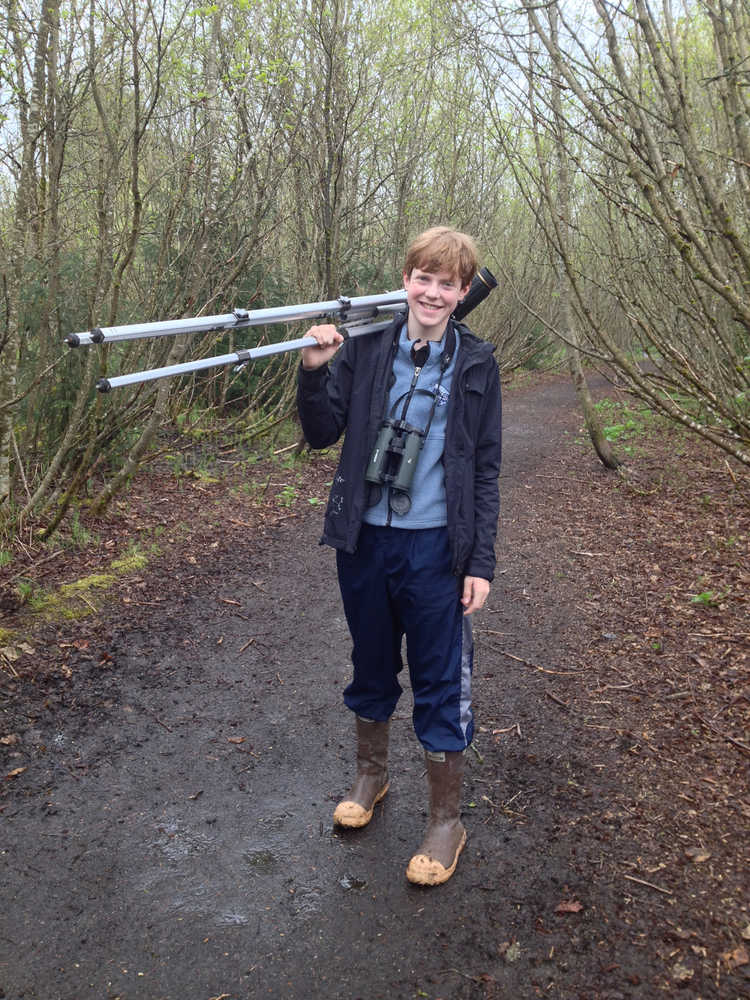When 14-year-old Owen Squires first looked through a pair of binoculars and told his mother the bird she’d seen flitting around the Juneau Community Garden’s weed pile was a hooded oriole, she didn’t believe him.
Now, birders have traveled to Juneau from as far away as Anchorage and Fairbanks for a chance to see the bird. It normally lives in Mexico, California, and more southerly regions; it’s the first time it’s been spotted in Alaska.
On Sept. 19, the Squires family was out at the garden. Marsha Squires was throwing away weeds when she saw “a flash of black and bright, bright yellow.”
She called her son Owen, age 14, over to see the bird. The two of them have been birding for years, she said, at least since Owen was four.
“He knows when I yell ‘Owen! Owen!’ it’s something exciting,” she said.
At first, Marsha thought the bird might be a western tanager, a similarly colored bird with a reddish head. Her husband got the binoculars out of the car and gave them to Owen.
“He (Owen) said ‘Mom, that’s an oriole,’” she said. “I said ‘No way, honey, there aren’t orioles in Juneau.’”
Owen added that it was a hooded oriole.
When Marsha looked through the binoculars herself, however, “there it was, plain as day for us,” she said.
“I’ve seen a couple orioles in Mexico, and so I kind of knew what most orioles looked like,” Owen Squires said. “Basically, it had a black throat, and I figured it out by the black throat.”
“I had to apologize to my kid,” Marsha Squires said. “Moms can be wrong.”
Local birder Gus van Vliet said a new species being sighted in Juneau first is relatively rare.
Tuesday, National Park Service employees saw and photographed a yellow-throated warbler in Bartlett Cove. That’s also a first for Alaska.
“This might be all tied into a different climate pattern, because we’re right in the midst of the beginning of a pretty substantial El Niño event this upcoming fall and winter,” van Vliet said. “This might be a harbinger of things to come.”
There are also a lot more birders in Alaska than there used to be, which may contribute to first-time sightings, said Bob Armstrong, naturalist and author of the book “Guide to the Birds of Alaska.” Armstrong posted a video of the oriole on his blog, www.naturebob.com.
“We have more eyes out there,” he said. “It definitely could be due to climate change, or habitat destruction down south. I don’t really know, for that one.”
Armstrong and fellow birder Doug Jones used the unusual sighting to observe and video what, according to the literature, isn’t normal behavior: the bird got nectar from flowers by approaching them from the bottom and sipping.
“According to the literature, they pierce the upper part of the flower and steal the nectar without benefiting the flower,” Armstrong said. “It definitely is not piercing the flower. It’s coming in from the bottom and getting the nectar.”
The arrival of the bird is “once in a lifetime, theoretically,” van Vliet said. Hooded orioles typically like dry and hot or warm weather and can be found singing in palm trees.
“No one knows (what will happen to the bird now,),” van Vliet said. “Sometimes they do (fly south) and sometimes they don’t, and sometimes we just don’t know, and that’s the lion’s share of these kinds of instances.”
“It was just really, really thrilling to see it,” Marsha Squires said. “It’s just such an interesting find…. What a great opportunity for people in Juneau to see an incredible bird.”
• Contact Juneau Empire outdoors writer Mary Catharine Martin at maryc.martin@juneauempire.com.

